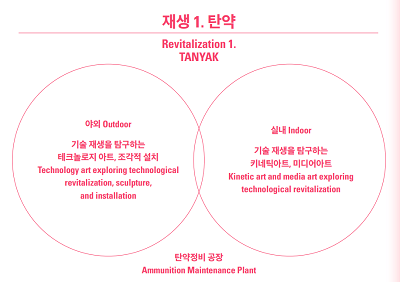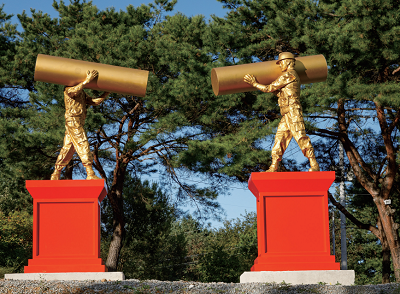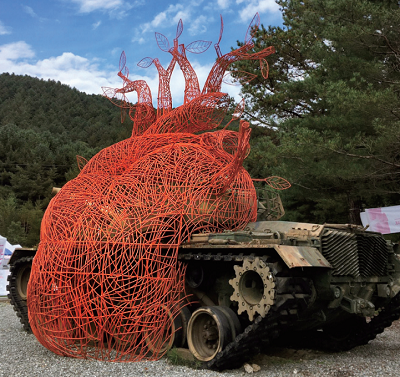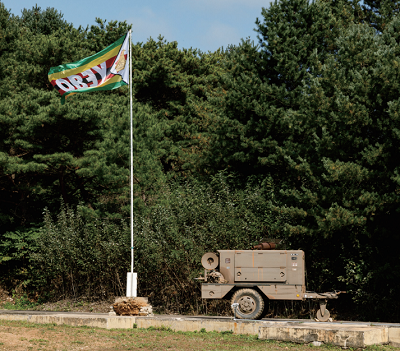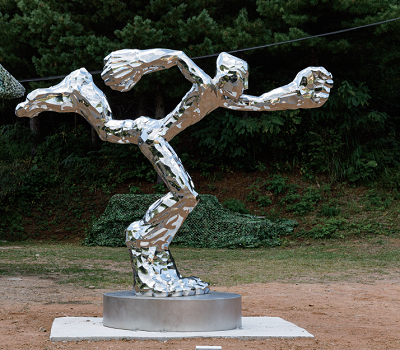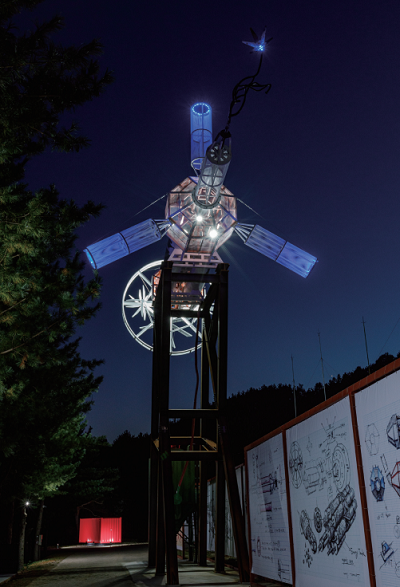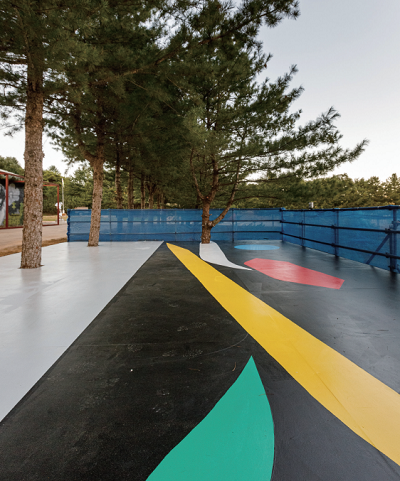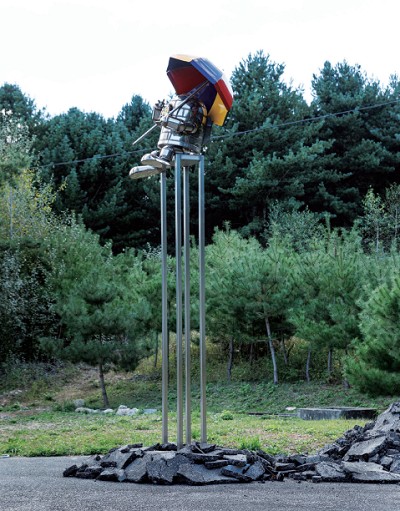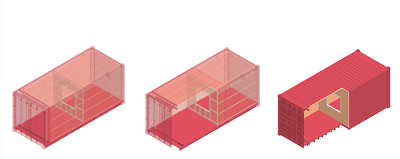강원국제트리엔날레2021 출품작 해설
재생1 탄약 (야외)
김성호(강원국제트리엔날레2021 예술감독)
한국 작가 임영선의 작품, <2068>
2068 by Youngsun LIM of Korea
탄약창고 언덕에 금빛의 노동자상이 우뚝 서 있습니다. 작품 제목이 2068입니다. 작가는 2068년을 ‘기계가 인간을 대신해서 일하는 까닭에 땀을 흘리며 일하는 노동자가 사라진 시대’로 상상합니다. 앞으로 반세기가 되지 않는 시간 뒤에 노동자가 사라지다니, 생각만 해도 아찔합니다. 노동자가 사라진 미래에는 노동자상만이 기념비로 남을 테지요. 금빛의 인물상과 붉은 조각대의 희망 가득한 색상과 달리 이 작품은 곧 닥칠지도 모를 검은빛의 우울한 미래를 비판적으로 경고합니다. 따라서 이 작품은 역설적으로 노동의 소중한 가치를 일깨우고 있다고 하겠습니다.
On the hill of the former ammunition maintenance factory stands a golden worker statue. The work is titled 2068. Youngsun LIM imagines the year 2068 as 'the age where manual workers are nowhere to be found because of machines replacing humans.’ It is mind-boggling to picture a day when all workers are gone in less than half a century from now. With all the workers gone, only the statue of a worker will remain as a monument in the future. Contrary to the glaring gold and red colors of the statue and stand, the work warns the viewers of the dark and gloomy future that may be just around the corner. It would be fair to say that this work paradoxically shows how precious labor is.
한국 작가 임옥상의 작품, <평화의 나무 II>
Tree of Peace II by Ok-Sang LIM, of Korea
탄약정비 공장 야외에 커다란 흙 언덕이 있습니다. 강원키즈트리엔날레 2020에 참여했던 작품이죠. 작가는 가을이 오기 전에 기존의 작품 외벽에 씨를 뿌렸습니다. 행사가 시작될 9월 말에는 코스모스와 각종 꽃들이 어우러져 가을 향을 물씬 풍겨낼 겁니다. 이번 강원국제트리엔날레2021이 지향하는 따스한 재생이 이렇게 펼쳐집니다. 과거의 것으로부터 새로운 것으로, 이전의 것으로부터 이후의 것으로 말이죠. 이제 작품 위 꼭대기에 있는 소망과 희망의 나무가 함께 이야기 나눌 친구들이 생겼군요. 꽃들과 그리고 우리 말입니다.
There is a large dirt hill outside the Ammunition Maintenance Plant. It was an artwork that participated in at the Gangwon Kids Triennale 2020. The artist sowed seeds on the side of the previous work before autumn. At the end of September, when the event will begin, cosmos and various flowers will blend together to give off the scent of autumn. This is the kind of ‘warm revitalization’ that Gangwon Triennale 2021 aims for. From the past to the new, from the past to the after. Now the tree of ‘wish and hope’ at the top of the artwork has friends as ‘flowers and us’ to talk with.
한국 작가 고요한의 작품, <생명의 싹>
Sprout of Life by YoHan KO of Korea
군사시설이었던 탄약창고 부지에 자리한 실물의 탱크 한 대를 둥근 형상의 조각이 포근하게 감싸 안고 있습니다. 네. 무서운 포탄을 쏘아대는 탱크를 감싸 안은 따스한 피가 흐르는 심장입니다. 두 개가 모두 같은 철 구조물이지만, 하나는 냉혹한 파괴를 또 다른 하나는 뜀박질하는 생명을 전합니다. 과거에 전쟁을 거쳤고 혹시 모를 전쟁을 준비해야만 하는 수많은 국가들은 미래를 어떻게 준비해야만 할까요? 작가는 파괴와 죽음을 낳는 전쟁의 상징 위에 평화와 생명의 상징을 올려놓고 우리에게 생명의 싹을 함께 키워나가길 권유합니다. 그는 말합니다. “해결책은 멀리 있지 않습니다. 전쟁 대신 사랑과 평화 그리고 생명”!
A round-shaped sculpture gently embraces a life-sized tank placed on the site of the former ammunition maintenance factory, a former military facility. Yes, it is a heart, pumping warm blood, that embraces the tank that fires terrifying shells. Both of them are made of the same material, steel, yet one conveys ruthless destruction while the other delivers a jumping and running force of life. How should the numerous countries brace themselves for the future, having been at war in the past and preparing for a potential one? YoHan KO places the symbol of peace and life on top of the symbol of war that begets destruction and death and invites us to grow the sprout of life together. The artist says, “The solution is not far. Love, peace, and life, in place of war.
짐바브웨 작가 댄 홀터의 작품, <오베이 / 이에보>
OBEY / YEBO by Dan HALTER of Zimbabwe
작가는 탄약정비공장에 가설 건축물이 있었던 것으로 추정되는 시멘트 블록 위에 깃발을 세웠습니다. 이 깃발에는 짐바브웨 국기에 ‘복종하다’는 뜻의 단어 ‘오베이(OBEY)’가 인쇄되어 있습니다. 관객은 깃발 앞면에 인쇄된 이 작품의 뒷면에서 얇은 천의 특성상 거꾸로 된 이미지와 글자를 보게 되는데 흥미롭게도 그 글자는 ‘이에보(YEBO)’로 ‘좋다’라는 의미를 담고 있습니다. 혼란의 식민 역사와 공포의 독재 시대를 경험했던 짐바브웨 국민으로서, 국가의 위상에 대해서 고민하는 한 예술가의 고민이 이 작품에 절절하게 반영되어 있다고 하겠습니다. 재기발랄하면서도 엄중한 정치의식이 혼재한 개념미술이라 하겠습니다.
Dan Halter planted a flag on a cement block that supposedly had a temporary structure at the former ammunition maintenance factory site. On the national flag of Zimbabwe is printed OBEY, meaning to submit. On this other side of the work, the viewer would see the reversed image of the word as the fabric is thin enough to allow that. There, the word reads YEBO, which means good. As a Zimbabwean who experienced chaotic colonial rule and years of terrifying dictatorship, Dan Halter captures his desperate concerns about the status of his nation in this work. The work embodies a conceptual art, bringing together wit and solemn political awareness.
한국 작가 김성복의 작품, <바람이 불어도 가야한다>
Must Go Against the Wind by Sung bok KIM of Korea
스테인리스 스틸로 된 커다란 인물상이 앞을 향해 힘차게 걸음을 옮기고 있습니다. 발 한쪽을 높이 들고 두 팔을 힘차게 휘두르는 포즈를 보니 목표를 향하여 나가는 일이 쉽지는 않은 모양입니다. 거센 바람을 세차게 맞고 있고 있기 때문이죠. ‘바람이 불어도 가야한다’는 작품명은 현대인이 뜻한 바를 향하여 가는 길에 만나게 되는 여러 고난의 상황들을 떠올리게 만듭니다. 삶 속의 고난뿐 아니라 코로나와 환경 속 재난과 같은 어려움을 모두 아우르면서 말이죠. 작가는 이러한 어려움을 진취적으로 극복해 나갈 것을 우리 모두에게 당부합니다.
A gigantic stainless steel statue is vigorously marching. With one foot raised high and both arms strenuously, it seems not easy for the statue to move toward the goal. That's probably because he is walking against the headwind. The title of the work Must Go Against the Wind reminds us of various hardships that the contemporaries face as they continue their journey toward their goal; various hardships not just in life, but also external hardships, such as the pandemic and environmental disasters. Sung bok KIM calls on all of us to overcome these challenges with courage.
한국 작가 김진우의 작품, <J-6 - 자연, 인간과 기계를 품다>
The Secret of Evolution: #J-6 - Natural, Embracing the Human and Mechanical by Jinwoo KIM of Korea
탄약정비공장의 전면을 에워싼 채 높이 치솟아 있는 이 작품은 ‘모뉴멘탈 파빌리온’입니다. 거대한 건축적 구조물이자 대형 미술 작품인 셈이죠. 작가는 높이 세운 두꺼운 철 구조물 위에 조명 빛을 번쩍이면서 전기 모터의 힘으로 돌아가거나 자연 풍력에 의해서 움직이는 ‘키네틱 아트’를 선보입니다. 탄약을 정비하던 공장의 내부 이미지를 밖으로 연장하고 공장이란 옛날의 사전적 의미를 현대적으로 재해석한 작품인 셈입니다. 그것은 마치 ‘여러 환경의 변화를 거치면서 진화한 상상의 기계 생물체’처럼 보입니다.
Rising along the façade of the former ammunition maintenance factory is the monumental pavilion, a massive architectural structure, as well as a large-scale artwork. Jinwoo KIM presents kinetic art powered by an electric motor or natural wind while blinking on a tall, thick steel structure. The work takes the image inside the factory where ammunitions were maintained to the outside and reinterprets the meaning of a factory, a rather old term in a contemporary sense. The work looks like an imaginary mechanical creature that has evolved through a series of environmental changes.
라트비아 작가, 일그바르스 잘란스의 작품, <긴 여정 짧은 재회>
Long Journey, Short Reunion by Ilgvars ZALANS of Latvia
탄약정비공장 야외에 새로운 나무 데크가 생겼습니다. 탄약정비공장에 난 길을 따라 심은 커다란 가로수 밑으로 이어진 내리막 능선에 작품이 놓일 자리를 새롭게 마련했습니다. 계곡처럼 생긴 내리막 공간에 조성된 데크 위에 올라선 작가의 작품은 회화로 반추하는 ‘그림일기’입니다. 한국에서 작업한 경험이 있는 작가가 추억을 떠올리며 자신의 이전 작업들을 회화적 패턴으로 다시 재생한 것이기 때문입니다. 기하학적 추상 회화인데 앞쪽에 가로수를 둘러싼 검은 구멍 하나가 눈에 띕니다. 그것은 구멍이 아닙니다. 그가 반타블랙 효과를 내는 검정색 물감을 통해서 만들어 낸, 눈속임 회화인 셈입니다. 관객 역시 이 작품 앞에서 짧은 만남이지만, 긴 예술의 여정을 시작할 듯싶습니다.
A new wooden deck has been built outside the Ammunition Maintenance Plant. A new deck was created for the artwork to be placed on a downhill ridge under a large boulevard planted along the road around the Ammunition Maintenance Plant. The artist's artwork drawn on the deck floor built on a downhill space that looks like a valley is a ‘picture diary’ that reflects through painting. The reason it is called a ‘picture diary’ is because an artist with experience in art activities in Korea recreated his previous works in a pictorial pattern, recalling memories of that time. It is a geometric abstract painting. However, one 'deep hole' on the deck floor surrounding the street tree stands out. No, it's not a hole. To be precise, it's a ‘trick painting’ painted with black paint that produces a vanta black effect. Most of the visitors, like artists, are likely to start a long artistic journey through a brief encounter with this work.
한국 작가 나인성의 작품, <잠수함 로봇_바라보다>
Submarine Robot_Watching by In-Sung NA of Korea
탄약정비공장 옆에 지킴이가 있습니다. 높은 의자 위에 올라가서 주위를 바라보면서 비가 오나 눈이 오나 우산을 받쳐 들고 탄약정비공장을 든든히 지키고 있는 로봇입니다. 그런데 아스콘으로 된 바닥을 뚫고 하늘 높이 올라가 있는 이 로봇은 잠수함 로봇입니다. 아마도 하늘의 푸른빛을 심해의 물빛으로 오인했나 봅니다. 작가는 쥘 베른이 쓴 고전 과학 소설 ‘해저 2만리’에 등장하는 네모 선장이 ‘상상의 잠수함’을 만들었던 것처럼, 자신만의 잠수함 로봇으로 상상의 항해를 시작합니다. 트리엔날레가 끝나면 이 잠수함 로봇은 지킴이 역할을 마치고 심해를 찾아 어디론가 떠나고 없겠죠?
Next to the ammunition maintenance factory stands a guard. It is a robot that climbs up on a high chair, looks around, and looks after the factory while holding an umbrella, whether it snows or rains. This robot that broke through the ascon floor and rose high is a submarine robot. Probably, it mistook the blue sky for the color of the deep sea. Just as Captain Nemo made his fictional submarine Nautilus in Jule Verne’s classic science fiction Twenty Thousand Leagues Under the Sea, the artist embarks on an imaginary voyage on his submarine robot. When the Triennale is over and the submarine robot did its part, it may leave for the deep sea and be nowhere to be seen.
한국 작가 이명호의 작품, <거꾸로, 다시…>
Reversing, Again… by Myoung ho LEE of Korea
탄약정비공장 옆에 컨테이너로 만들어진 커다란 카메라가 설치되어 있습니다. 그런데 이 카메라는 오늘날의 카메라가 아닌 옛날 카메라입니다. 옛날 카메라라고요? 이것은 렌즈 대신 바늘구멍으로 커다란 상자 안에 빛을 보내 거꾸로 상이 맺히게 만든 ‘핀홀 카메라’ 또는 ‘카메라 옵스큐라’인 셈인데요. 작가는 이러한 장치를 현대적으로 새롭게 만들었습니다. 작가는 탄약정비공장 주위의 자연 풍경을 불러와 상자 안에 거꾸로 비춰주고 그 안에 들어간 관객들이 그 풍경을 따라 그릴 수 있게 하는 참여 프로그램도 함께 진행합니다. ‘거꾸로 다시...’라는 작품명은 ‘다시 시작’이라는 의미를 담은 트리엔날레의 주제, ‘따스한 재생’을 연상케 하네요.
Next to the former ammunition maintenance factory is a large camera made of containers. This is an old camera, not today's one. An old camera? This is a pinhole camera or camera obscura of sorts that sends light into a large box through the eye of a needle instead of a lens to form an image upside down. Myung ho Lee created such a device in a contemporary manner. A participation program is also prepared where the natural scenery around the ammunition maintenance factory is brought in upside down in the box, and the audience who goes inside it can draw along the image. The title Reversing, Again… reminds us of the theme of the Triennale Warm Revitalization, which means 'start again.

